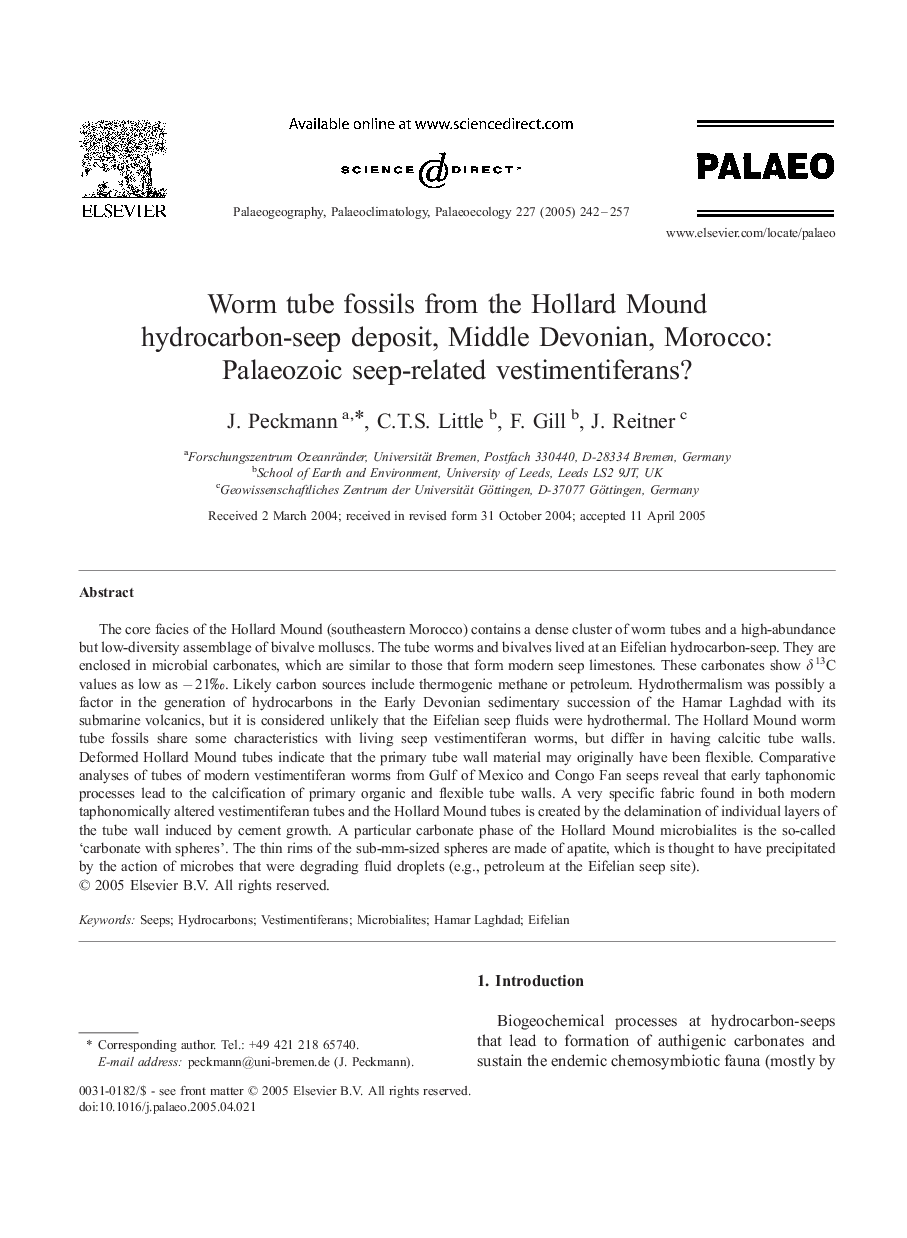| کد مقاله | کد نشریه | سال انتشار | مقاله انگلیسی | نسخه تمام متن |
|---|---|---|---|---|
| 9463001 | 1622385 | 2005 | 16 صفحه PDF | دانلود رایگان |
عنوان انگلیسی مقاله ISI
Worm tube fossils from the Hollard Mound hydrocarbon-seep deposit, Middle Devonian, Morocco: Palaeozoic seep-related vestimentiferans?
دانلود مقاله + سفارش ترجمه
دانلود مقاله ISI انگلیسی
رایگان برای ایرانیان
کلمات کلیدی
موضوعات مرتبط
مهندسی و علوم پایه
علوم زمین و سیارات
فرآیندهای سطح زمین
پیش نمایش صفحه اول مقاله

چکیده انگلیسی
The core facies of the Hollard Mound (southeastern Morocco) contains a dense cluster of worm tubes and a high-abundance but low-diversity assemblage of bivalve molluscs. The tube worms and bivalves lived at an Eifelian hydrocarbon-seep. They are enclosed in microbial carbonates, which are similar to those that form modern seep limestones. These carbonates show δ13C values as low as â 21â°. Likely carbon sources include thermogenic methane or petroleum. Hydrothermalism was possibly a factor in the generation of hydrocarbons in the Early Devonian sedimentary succession of the Hamar Laghdad with its submarine volcanics, but it is considered unlikely that the Eifelian seep fluids were hydrothermal. The Hollard Mound worm tube fossils share some characteristics with living seep vestimentiferan worms, but differ in having calcitic tube walls. Deformed Hollard Mound tubes indicate that the primary tube wall material may originally have been flexible. Comparative analyses of tubes of modern vestimentiferan worms from Gulf of Mexico and Congo Fan seeps reveal that early taphonomic processes lead to the calcification of primary organic and flexible tube walls. A very specific fabric found in both modern taphonomically altered vestimentiferan tubes and the Hollard Mound tubes is created by the delamination of individual layers of the tube wall induced by cement growth. A particular carbonate phase of the Hollard Mound microbialites is the so-called 'carbonate with spheres'. The thin rims of the sub-mm-sized spheres are made of apatite, which is thought to have precipitated by the action of microbes that were degrading fluid droplets (e.g., petroleum at the Eifelian seep site).
ناشر
Database: Elsevier - ScienceDirect (ساینس دایرکت)
Journal: Palaeogeography, Palaeoclimatology, Palaeoecology - Volume 227, Issues 1â3, 28 October 2005, Pages 242-257
Journal: Palaeogeography, Palaeoclimatology, Palaeoecology - Volume 227, Issues 1â3, 28 October 2005, Pages 242-257
نویسندگان
J. Peckmann, C.T.S. Little, F. Gill, J. Reitner,